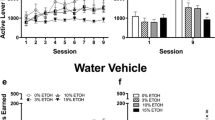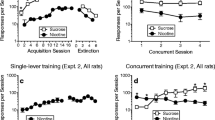Abstract
A series of experiments evaluated the determinants of preference for mixtures of ethanol plus sucrose relative to sucrose in rats. One dipper served 10% ethanol mixed with 10% sucrose, and the second dipper served 10% sucrose. Lever presses operated each dipper according to a variable-interval 5-s schedule. In three experiments the subjects were given pre-session meals of sucrose (2.5–20 ml) or sucrose (20 ml) plus chow (5 or 10 g). Pre-session meals decreased responding maintained by sucrose but not responding maintained by ethanol mixture. In two experiments body weight was varied from 85% to 125% of the initial free-feeding values. Increases in body weight, like pre-session meals, decreased responding reinforced by sucrose, but typically did not decrease responding reinforced by ethanol mixture. Throughout most of the study, ethanol consumption remained at about 1.25 ml per half hour session (3–4 g/kg per 30 min). For example, pre-session access to ethanol mixture decreased within-session ethanol consumption, but total consumption, counting both sources, remained about 1.25 ml/session. The within-session patterns of responding also differed. Responding reinforced by ethanol mix decreased as a function of ethanol consumption, whereas responding reinforced by sucrose was relatively constant throughout the session. The simplest explanation of the results is that ethanol's pharmacological consequences regulated preference.
Similar content being viewed by others
References
Amit Z, Stern MH (1969) Alcohol ingestion without oropharyngeal sensations. Psychon Sci 15:162–163
Baumol WJ, Blinder AS (1988) Economics, principles and policy, microeconomics, 4th edn. Harcourt Brace Jovanovich, San Diego
Berman R, Cannon, D (1974) The effect of prior ethanol experience on ethanol-induced saccharin aversions. Pharmacol Biochem Behav 12:1041–1044
Davies BT, Parker LA (1990) Novel versus familiar ethanol: a comparison of aversive and rewarding properties. Alcohol 7:523–529
de Villiers PA, Herrnstein RJ (1976) Toward a law of response strength. Psychol Bull 83:1131–1153
Dole VP (1986) On the relevance of animal models to alcoholism in humans. Alcohol Clin Exp Res 10:361–363
Findley JD (1958) Preference and switching under concurrent scheduling. J Exp Anal Behav 1:123–144
Fleshler M, Hoffman HS (1962) A progression for generating variable-interval schedules. J Exp Anal Behav 5:529–530
Gilbert RM (1974) Effects of food deprivation and fluid sweetening on alcohol consumption by rats. Q J Stud Alcohol 35:42–47
Gill JH, Nielson HC (1979) A specific arousal effect from barpressing on nonspecific arousal in rats. Physiol Psychol 7:447–450
Green L, Rachlin H (1991). Economic substitutability of electrical brain stimulation, food, and water. J Exp Anal Behav 55:133–143
Herrnstein RJ (1970) On the law of effect. J Exp Anal Behav 13:243–266
Heyman GM (1993) Response requirement increases fail to decrease preference for ethanol beverage in rats [Abstract] Alcohol Clin Exp Res 17:480
Heyman GM, Oldfather CM (1992) Inelastic preference for ethanol in rats: an analysis of ethanol's reinforcing effects. Psychol Sci 3:122–130
Hursh S (1978) The economics of daily consumption controlling food- and water-reinforced behavior. J Exp Anal Behav 29:475–491
Kahn M, Stellar E (1960) Alcohol preference in normal and anosmic rats. J Comp Physiol Psychol 53:571–575
Kiefer SW, Bice PJ, Orr MR, Dopp JM (1990) Similarity of taste reactivity responses to alcohol and sucrose mixtures in rats. Alcohol 7:115–120
Kimble GA (1961) Hilgard and Marquis' conditioning and learning, 2nd edn. Appleton-Century-Crofts, New York
Lea S, Roper T (1977) Demand for food on fixed-ratio schedules as a function of the quality of concurrently available reinforcement. J Exp Anal Behav 27:371–380
Lester D, Freed EX (1973) Criteria for an animal model of alcoholism. Pharmacol Biochem Behav 1:103–107
Mansfield E (1982) Microeconomics, theory and applications, 4th edn. W.W. Norton, New York
McSweeney FK (1975) Concurrent schedule responding as a function of body weight. Anim Learn Behav 3:264–270
Meisch R, Thompson T (1973) Ethanol as a reinforcer: effects of fixed ratio size and food deprivation. Psychopharmacology 28:171–183
Meisch R, Thompson T (1974) Ethanol intake as a function of concentration during food deprivation and satiation. Pharmacol Biochem Behav 2:589–596
Pfeffer AO, Samson HH (1985) Oral ethanol reinforcement: Interactive effects of amphetamine, pimozide, and food-restriction. Alcohol Drug Res 6:37–48
Rachlin HC, Green L, Kagel JH, Battalio RC (1976) Economic demand theory and psychological studies of choice. In: Bower G (ed) The psychology of learning and motivation, vol 10. Academic Press, New York, pp 129–154
Richter CP, Campbell KH (1940) Alcohol taste thresholds and concentrations of solutions preferred by rats Science 91:507–508
Roehrs TA, Samson HH (1982) Relative responding on concurrent schedules: indexing ethanol's reinforcing efficacy. Pharmacol Biochem Behav 15:539–544
Rozin P, Kennel K (1983) Acquired preferences of piquant foods by chimpanzees. Appetite 4:69–77
Samson HH (1987) Initiation of ethanol-maintained behavior: a comparison of animal models and their implication to human drinking. In: Thompson T, Dews P, Barrett J (eds) Advances in behavioral pharmacology, vol. 6. Erlbaum, Hillsdale
Sheffield FD, Roby TB (1950) Reward value of a nonnutritive sweet taste. J Comp Physiol Psychol 43:471–481
Schwarz-Stevens K, Samson HH, Tolliver GA, Lumeng L, Li T-K (1991) The effects of ethanol initiation procedures on ethanol reinforced behavior in the alcohol-preferring rat. Alcohol Clin Exp Res 15:277–285
Snyderman M (1983) Body weight and response strength. Behav Anal Letts 3:255–265
Stewart RB, McBride WJ, Lumeng L, Li T-K (1991) Chronic alcohol consumption in alcohol preferring P rats attenuates subsequent taste aversion produced by ethanol injections. Psychopharmacology 105:530–534
Tatham TA, Zurn KR (1989) The MED-PC experimental apparatus programming system. Behav Res Methods, Instr Comp 21:294–302
Waller MB, McBride WJ, Lumeng L, Li T-K (1982) Induction of dependence on ethanol by free-choice drinking in alcohol preferring rats. Pharmacol Biochem Behav 16:501–507
Williams BA (1988) Reinforcement, choice, and response strength. In Atkinson RC, Herrnstein RJ, Lindzey G, Luce RD (eds) Stevens' handbook of experimental psychology, 2nd edn. Wiley, New York, pp 167–244
Author information
Authors and Affiliations
Rights and permissions
About this article
Cite this article
Heyman, G.M. Ethanol regulated preference in rats. Psychopharmacology 112, 259–269 (1993). https://doi.org/10.1007/BF02244920
Received:
Revised:
Issue Date:
DOI: https://doi.org/10.1007/BF02244920




